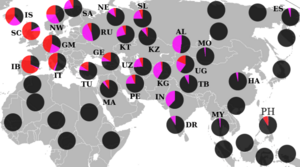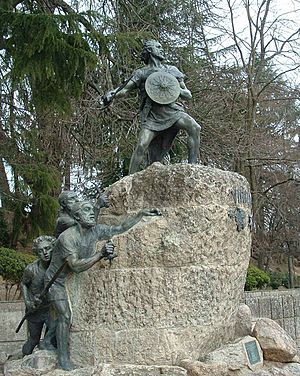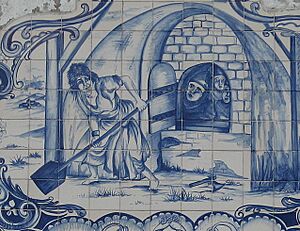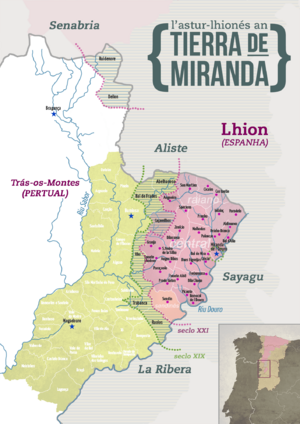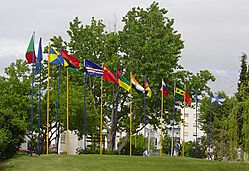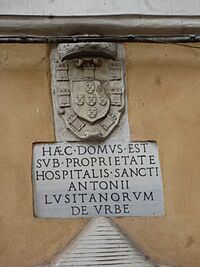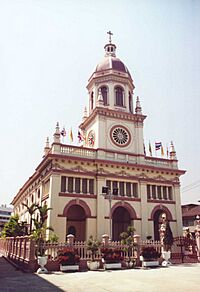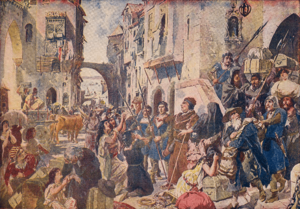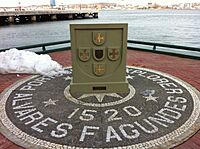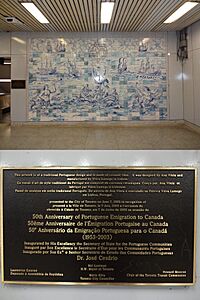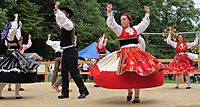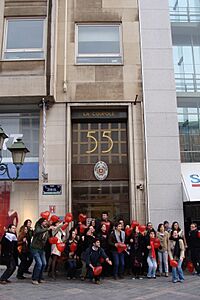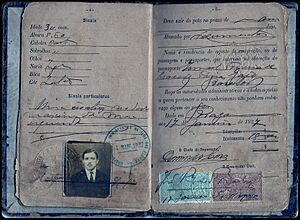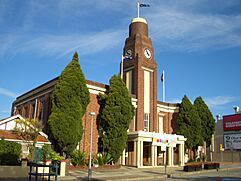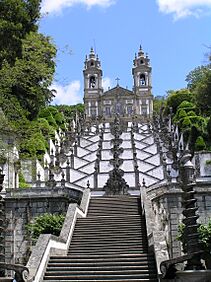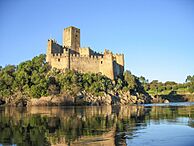Portuguese people facts for kids
| Portuguese: Portugueses, Portuguesas | |
|---|---|
 |
|
| Total population | |
| Portugal: c. 10.6 million | |
| Regions with significant populations | |
| c. 5,000,000 (includes Portuguese nationals and their descendants down to the third generation; excludes more distant ancestry) | |
| 2,000,000 (Portuguese born & ancestry) | |
| 1,400,000 (Portuguese ancestry) | |
| 1,300,000 (ancestry) (additional 55,441 Portuguese born) |
|
| 550,000 (Portuguese ancestry) | |
| 500,000 | |
| 460,173 | |
| 244,217 | |
| 200,000 (42,008 citizens) | |
| 200,000 | |
| 184,774 | |
| 170,000 | |
| 152,616 | |
| 151,028 | |
| 100,000 (Bayingyi) | |
| 80,654 | |
| 80,000 | |
| 73,903 | |
| 42,000 | |
| 40,000 (Burgher) | |
| 40,000 (Kristang) | |
| 35,633 | |
| 22,318 (ancestry) | |
| 20,853 | |
| 20,700 | |
| 19,000 | |
| 18,000 | |
| 17,000 | |
| 16,308 | |
| 16,000 (ancestry) (1,643 Portuguese born) |
|
| 15,000 | |
| 10,400 | |
| 9,542 | |
| 9,000 | |
| 8,288 | |
| 7,971 | |
| 7,245 | |
| 6,400 | |
| 5,700 | |
| Languages | |
| Portuguese | |
| Religion | |
| Predominantly Roman Catholic | |
| Related ethnic groups | |
| Other Romance-speaking peoples Especially Galicians, Spaniards, and other Lusophones |
|
|
Total number of ethnic Portuguese varies wildly based on the definition. |
|
The Portuguese people (called Portugueses for males and Portuguesas for females in their language) are a group of people who come from Portugal. Portugal is a country in the southwest of Europe, on the Iberian Peninsula. Portuguese people share a common culture, ancestry, and the Portuguese language.
The country of Portugal started as the County of Portugal in 868. However, it became a recognized kingdom after the Battle of São Mamede in 1128. This was confirmed by the Treaty of Zamora and a special paper from the Pope called Manifestis Probatum. This event in the 12th century helped the Portuguese people become a united nation.
Portuguese people were very important in sailing and exploring the world. They discovered many lands in the Americas, Africa, Asia, and Oceania that Europeans didn't know about before. In 1415, Portugal began the Age of Discovery by conquering Ceuta. This led to the creation of the Portuguese Empire, one of the first global empires. It was a major power in the 15th and 16th centuries, with lands that are now part of many countries. Portugal helped shape Western culture alongside other European nations.
Because the Portuguese Empire was so large and lasted for a long time, Portuguese people spread to many parts of the world. This happened through colonization in Asia, Africa, and the Americas, as well as through people moving away from Portugal over time.
Contents
- Who Are the Portuguese People?
- How Rome Changed Portugal
- Portugal in the Middle Ages
- The Birth of the Portuguese Nation
- Portuguese People Today
- Portuguese People Around the World
- Portuguese Culture
- Food and Cooking
- Buildings and Design
- Music and Sounds
- Movies and Films
- Images for kids
- See also
Who Are the Portuguese People?
Ancient Roots of the Portuguese
The Portuguese people's background comes mostly from ancient groups like the Lusitanians and Celts. These groups were later influenced by the ancient Romans after the Romans conquered the Iberian Peninsula. Because of Roman rule, the Portuguese language comes from Vulgar Latin. This is the everyday Latin spoken by common people.
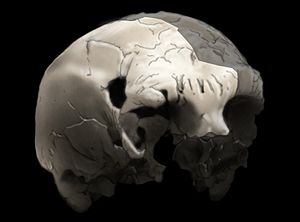
Some male family lines in Portugal come from Germanic peoples like the Suebi and Visigoths. These groups arrived as rulers after the Roman period, starting in 409. They made up a small part of the population but had a big impact.
The Moorish rule in Iberia, from the early 8th century to the 12th century, also left small genetic traces from Moorish, Jewish, and Saqaliba people. Other smaller influences include Viking settlements between the 9th and 11th centuries. These Norsemen raided coastal areas, especially in northern Portugal.
What Does the Name "Portugal" Mean?
The name Portugal, which the Portuguese people get their name from, comes from two words. One is the Latin word Portus, meaning "port." The second word is Cale, and its meaning is not fully clear. Cale might be linked to the Gallaeci, a Celtic tribe that lived in what is now Northern Portugal.
Another idea is that the name comes from an early settlement called Cale (now Gaia). This town was located at the mouth of the Douro River on the Atlantic coast, forming "Portus Cale." The word Cale might come from the Celts, meaning "shelter" or "door." Some even think Cale comes from the Greek word kalós, meaning "beautiful."
During the Middle Ages, the area around Cale was known as Portucale by the Visigoths. This name later changed to Portugale, or Portugal, by the 9th century. The term referred to the land between the Douro and Minho rivers.
Early People in Portugal
The earliest modern humans in Portugal were likely Paleolithic people. They arrived in the Iberian Peninsula about 35,000 to 40,000 years ago. Studies of DNA suggest that modern Portuguese people have some family lines from these ancient people. These early groups settled in Europe around 45,000 years ago, after the last ice age.
Northern Iberia was a safe place during the Ice age. From there, Paleolithic humans later spread across Europe. Migrations from this area link modern Iberians to people in Western Europe, especially the British Isles.
A common genetic marker, haplogroup R1b, is found in most of the Iberian Peninsula and Western Europe. In Portugal, this marker is found in 65% of people in the south and up to 87% in the north. In some areas, it reaches 96%.
How Farming Changed Portugal
Around 10,000 years ago, farming spread to Europe from Western Asia and the Middle East. This change, called the Neolithic period, also reached Iberia. Its biggest impact was in the southern and eastern parts of Europe.
Celts and Other Indo-Europeans
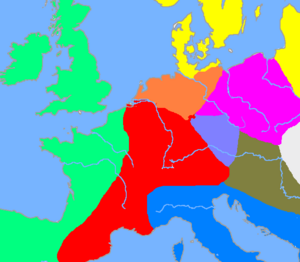
Around 3,000 BC, during the Bronze Age, the first people who spoke Indo-European languages arrived in Iberia. Later, waves of Celts also came. The Celts arrived in Portugal about 3,000 years ago, with strong migrations between the 7th and 5th centuries BC.
These groups shaped the culture of Iberia and Portugal. The northwest became more "Continental," while the southeast became more "Mediterranean." This difference can also be seen in genetics.
The Portuguese people's background is a mix of these early groups. These include pre-Celtic or para-Celts like the Lusitanians, and Celtic peoples like the Gallaeci and Celtici.
Lusitanians: Portugal's Ancient People
The Lusitanians were an Indo-European speaking people who lived in the western Iberian Peninsula. This was long before it became the Roman province of Lusitania. They spoke the Lusitanian language, but only a few written pieces of it remain.
Most Portuguese people see the Lusitanians as their ancestors. However, people in northern Portugal (Minho, Douro, Trás-os-Montes) feel more connected to the Gallaecians. Some experts believe that Gallaecian and Lusitanian were actually the same language.
The Lusitanians were a large tribe living between the Douro and Tagus rivers. They might have come from the Alps and settled in the region around 600 BC. Some scholars think they were native to the area and were first ruled by Celts before gaining independence.
The first place Lusitanians settled was probably the Douro Valley. They later moved south, expanding on both sides of the Tagus river. Eventually, they were conquered by the Romans.
Other Pre-Roman Tribes in Portugal
The Lusitanians fought fiercely against the Romans for their freedom. Because of this, the name Lusitania was used by other tribes fighting Roman rule in western Iberia. This is why the Romans named their province in the area Lusitania.
Here are some of the tribes that lived in what is now Portugal before Roman rule:
- Bardili (Turduli) – lived in the Setúbal peninsula.
- Bracari – lived between the Tâmega and Cávado rivers, near Braga.
- Callaici – lived along and north of the Douro river.
- Celtici – Celts living in Alentejo.
- Cynetes or Conii – lived in the Algarve and southern Alentejo.
- Paesuri – a tribe linked to the Lusitanians, living between the Douro and Vouga rivers.
- Turduli – lived in eastern Alentejo (Guadiana Valley).
- Vettones – lived in eastern border areas of Portugal and parts of Spain.
How Rome Changed Portugal
The Roman Republic conquered the Iberian Peninsula in the 2nd and 1st centuries BC. They took control from the powerful empire of Carthage during the Punic Wars.
The Lusitanians had been fighting Rome since 193 BC. They bravely defended themselves for years, even defeating the Romans many times. However, in 150 BC, the Roman leader Servius Galba tricked them. He killed 9,000 Lusitanians and sold 20,000 more as slaves.
Three years later, in 147 BC, Viriathus became the leader of the Lusitanians. He caused great trouble for Roman rule using guerrilla warfare. In 139 BC, Viriathus was betrayed and killed by his own companions, who were bribed by the Romans. However, the Romans later executed the traitors, saying, "Rome does not pay traitors."
Viriathus is seen as the first "national hero" for the Portuguese. After his death, the Lusitanians became more like the Romans, adopting their culture and the Latin language.
The Romans had a big impact on the people and culture of Portugal. The Portuguese language comes mostly from Latin. Roman rule lasted from the 2nd century BC to the 5th century AD.
Portugal in the Middle Ages

After the Romans, Germanic peoples like the Suebi and Visigoths ruled the peninsula for several centuries. They became part of the local populations. Some Vandals and Alans also stayed. Northern and central Portugal, along with Galicia, have the highest amounts of Germanic Y-DNA in the Iberian Peninsula today.
Small Viking settlements also existed between the 9th and 11th centuries. These Norsemen raided coastal areas, mainly in the northern regions of Douro and Minho.
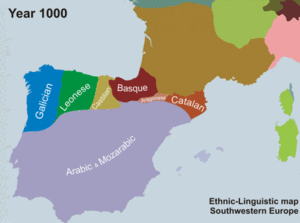
The Moors ruled parts of what is now Portugal from the 8th century until 1249. This was when they were expelled from the Algarve during the Reconquista. Some Moors and Jews converted to Christianity and became "New Christians." Genetic studies show that the Moorish rule left little genetic influence in most of Iberia.
After the Reconquista, religious minorities like "new Christians" and "Ciganos" (Roma gypsies) faced persecution. Many were forced to leave the country or were punished by the Holy Inquisition. This led to a Jewish diaspora in places like the Netherlands, England, and Brazil.
The Birth of the Portuguese Nation
The country of Portugal began with the founding of the County of Portugal in 868. This was the first time a strong sense of national identity appeared. Even during Roman times, the people living there came from different backgrounds.
Although Portugal started as a county in 868, it was officially recognized as a kingdom after the Battle of São Mamede on June 24, 1128. This was confirmed by the Treaty of Zamora and a special paper from the Pope. This event in the 12th century helped the Portuguese people become a united nation.
Another important moment for Portuguese nationalism was the Battle of Aljubarrota in 1385. This battle, linked to the brave figure of Brites de Almeida, stopped the Spanish from taking over the Portuguese throne.
Portuguese People Today
Population in Portugal
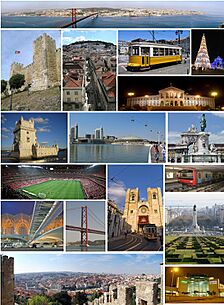
About 9.15 million people born in Portugal live in the country. This is out of a total population of 10.467 million, meaning 87.4% are Portuguese-born. Around 782,000 foreigners live legally in Portugal.
Portugal's population is getting older. The average age is 46.8 years, and people aged 65 or more make up 23.4% of the population. This is because fewer babies are being born, and people are living longer (life expectancy is 82.65 years).
Portugal has one of the lowest rates of babies dying in the world (2.6%). This shows that living conditions have improved a lot since 1961.
Most of the population (about 66.85%) lives in cities. People are mainly concentrated along the coast and in the Lisbon metropolitan area. About 2.8 million people, or 27.67% of the population, live in Lisbon.
Languages Spoken in Portugal
The main language spoken by most people in Portugal is Portuguese. Other native languages spoken in Portugal include:
- Caló: The language of the Portuguese-Romani community. About 52,000 Romani people live in Portugal.
- Mirandês: This language is officially recognized. It is spoken by about 15,000 people in the area of Miranda do Douro. All speakers also speak Portuguese.
- Barranquenhu: Spoken in the town of Barrancos. About 3,000 people speak this language. It is a mix of Portuguese and Spanish dialects.
- Portuguese Sign Language: The official language for the deaf community in Portugal. About 30,000 deaf people use this language.
Minority Groups in Portugal
People from former colonies like Brazil, Portuguese Africa, Macau, and East Timor have moved to Portugal since the 1900s.
Many people from Slavic countries, especially Ukrainians and Russians, have also moved to Portugal since the late 20th century. After the Russian invasion of Ukraine, many Ukrainian refugees arrived. They are now the second largest immigrant group after Brazilians.
There are also smaller groups from China, India, Nepal, Bangladesh, and Pakistan. From Latin America, Venezuelans are particularly present. About 52,000 Romani people also live in Portugal.
Portugal is also home to people from other European countries like France, Germany, and the UK. Officially, foreigners make up 7.3% of the population.
Regarding religious minorities, there are about 100,000 Muslims and a smaller group of Jews, about 5,000–6,000 people.
Most Portuguese surnames today have Germanic origins (like Henriques, meaning "son of Henrique"). Others come from places (like Gouveia), religious terms (like Cruz), jobs (like Carpinteiro for carpenter), or physical appearance (like Branco for white).
Portuguese People Around the World
Overview of the Portuguese Diaspora
Portugal has a long history of people moving to other countries. It is estimated that over one hundred million people worldwide have Portuguese ancestors. This is because of the explorations in the 15th and 16th centuries and the later colonial expansion.
Portuguese people moved to South Asia, the Americas, Macau, East-Timor, and Africa. This also led to communities with mixed Portuguese heritage, like the Goan Catholics in Goa or the Kristang in Malacca. The Portuguese Empire lasted almost 600 years, ending in 1999 when Macau was returned to China.
Many Portuguese also moved abroad in the 19th and 20th centuries for economic reasons. Between 1886 and 1966, Portugal was one of the top countries for emigration in Western Europe.
From the mid-19th century to the late 1950s, nearly two million Portuguese left Europe. They mainly went to Brazil, but also to the United States, Canada, and the Caribbean. Today, about 1.2 million Brazilian citizens were born in Portugal.
By 1989, about 4 million Portuguese citizens lived abroad. Most were in France, Germany, Brazil, South Africa, Canada, Venezuela, and the United States. In 2021, estimates suggest that up to 5 million Portuguese citizens might be living abroad.
In Europe, many Portuguese live in French-speaking countries like France, Luxembourg, and Switzerland. This is partly because the Portuguese and French languages are similar. Portuguese communities often feel a strong connection to their homeland, language, culture, and food like cod.
Portuguese Sephardi Jews Around the World
For many centuries, descendants of Portuguese Sephardi Jews have lived all over the world. Large communities settled in Israel, the Netherlands, the United States, France, Venezuela, Brazil, and Turkey.
Why They Left Portugal
The Portuguese Jewish diaspora happened mainly because of a decree in 1496 by the Portuguese monarchy. This order forced Jews in Portugal to either convert to Christianity or leave the country. This led to many Jews leaving Portugal and spreading across Europe and Brazil. Many early colonists in Brazil were also Sephardi Jews who had converted.
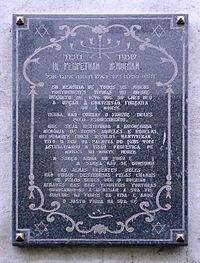
It is thought that up to 10,000 Portuguese Jews moved to France starting in 1497. Later, the Netherlands became a popular choice because there was no Inquisition there. These Portuguese Jews helped the economies and cultures of their new homes. They also built important places like the Esnoga in Amsterdam.
During the Shoah (Holocaust), nearly 4,000 Jews of Portuguese descent living in the Netherlands died. This was the largest group of Portuguese victims in the Nazi genocide. Even though Portugal was officially neutral during World War II, its government did not fully protect its citizens or other Jewish people living abroad. However, some Portuguese citizens, like Aristides de Sousa Mendes, helped thousands of Jews escape Nazi violence.
Portuguese Jews Today
In 2015, the Portuguese parliament officially recognized that the expulsion of its Jewish citizens was wrong. To try and fix this historical injustice, the government passed a "Law of Return." This law allows descendants of those persecuted Jews to get Portuguese citizenship if they can prove their Sephardic Jewish ancestry and a connection to Portugal.
Since 2015, over 140,000 people of Sephardic descent from 60 countries have applied for Portuguese citizenship. Most are from Israel or Turkey. However, some people without real historical links to Sephardic Jews also got citizenship. This led to a review of the law.
Portuguese in the Americas (Outside Brazil)
Portuguese in the United States

The United States and Portugal have had relations for hundreds of years. Portugal was the first neutral country to recognize the United States after the American Revolutionary War.
Portuguese explorers like João Fernandes Lavrador and João Rodrigues Cabrilho were among the first Europeans to explore parts of what is now the United States. The Dighton Rock in Massachusetts is a sign of early Portuguese presence.
Portuguese people started settling in large numbers in the US in the 19th century. Many came in the first half of the 20th century, especially from the Azores. The "Azorean Refugee Act of 1958" helped people affected by a volcano eruption. Later, the "Immigration Act of 1965" made it easier for people with relatives in the US to immigrate.
Large Portuguese communities are found in New Jersey (especially Newark), the New England states, California, and along the Gulf Coast (Louisiana). Hawaii also has a big Portuguese population. The Portuguese community in the US is the second largest in the Americas, after Brazil.
Portuguese in Canada
Canada, especially Ontario, Quebec, and British Columbia, has a large Portuguese community since the 1940s. Many Portuguese moved to Canada for job opportunities. They bought homes and started businesses, adding to Canada's cultural landscape.
In 2016, about 482,610 Canadians (1.4%) said they had full or partial Portuguese ancestry. Major Portuguese neighborhoods include Little Portugal in Toronto and Montréal. Montréal's "Petit Portugal" has many Portuguese shops and restaurants.
Portuguese Canadians are proud of their heritage. The Portuguese language is spoken by over 330,000 Canadians. This is one of the most important cultural contributions the Portuguese have made to Canada.
Early Portuguese exploration also influenced Canada. The name of the province Newfoundland and Labrador comes from Portuguese. "New found land" was called Terra Nova (new land) in Portuguese. Labrador is named after the Portuguese navigator João Fernandes Lavrador.
Portuguese in the Caribbean
In the Caribbean, Portuguese culture is strong even though Portugal never colonized these islands. From the 1830s, Portuguese people, especially from Madeira, came as indentured laborers. This happened after slavery was abolished in the British colonies. Portuguese, along with Indians and Chinese, were brought in to replace slave labor.
About 2,500 Portuguese went to Antigua and Barbuda. About 30,000 went to Guyana, and 2,000 to Trinidad and Tobago. In Guyana, the Portuguese heritage is still alive through businesses started by the community.
Portuguese fishermen, farmers, and laborers also settled in other Caribbean countries. These include Jamaica, St. Vincent and the Grenadines, Barbados, and Suriname. In Suriname, its first capital, Torarica, was founded by Portuguese-Jewish settlers.
The North Atlantic islands of Bermuda also have many Portuguese people. They came from the Azores, Madeira, and Cape Verde Islands since the 1840s.
Portuguese in Latin America (Excluding Brazil)
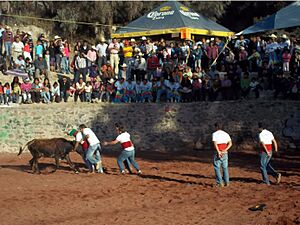
Mexico has seen Portuguese immigration since colonial times. Important settlements are in northeastern cities like Saltillo and Monterrey. Santiago Tequixquiac was a place where Portuguese Crypto-Jews settled. Many Portuguese traditions, like forcados (a bull-catching tradition), are still kept there.
Portuguese communities are also in Central American countries like Cuba and the Dominican Republic.
Venezuela has the largest number of Portuguese people in Latin America after Brazil. Portuguese people started arriving in Venezuela in the mid-20th century, especially from Madeira, for economic reasons. About 1.3 million people in Venezuela have Portuguese ancestry.
Colombia did not have large Portuguese immigration. Most Portuguese moved to countries like Brazil and Venezuela where immigration was encouraged. The Portuguese embassy in Bogota estimates about 800 Portuguese nationals live in Colombia.
In Peru, Portuguese immigration began during the time of the Viceroyalty of Peru. Many sailors and people who traveled the Amazon River settled there. About 2,000 Portuguese citizens live in Peru. However, up to 1 million Peruvians might have Portuguese ancestors.
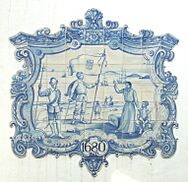
The Southern Cone region (Argentina, Uruguay, Chile) also had Portuguese immigration since the early 20th century. About 255,000 people in this region have Portuguese ancestry.
In Uruguay, many Portuguese are of Azorean descent. Portuguese presence dates back to 1680 with the founding of Colonia del Sacramento. Many Portuguese Brazilians also crossed the border into Uruguay.
In Argentina, Portuguese immigration was smaller compared to Brazil. However, Portuguese were the second-largest immigrant group before 1816. Many settled in Buenos Aires, working as sailors and porters.
Portuguese in Europe (Outside Portugal)
Portuguese in France, Belgium, Luxembourg, Monaco, Andorra, and Switzerland


Many Portuguese people moved to French-speaking countries in Europe in the 1960s. This included France, Belgium, Luxembourg, Monaco, and Switzerland. They moved for economic reasons and to avoid being forced to fight in Portugal's colonial wars. In Andorra, Portuguese people are the third largest ethnic group.
About 15.4% of Portuguese people can speak French well. French media is available in Portugal, and many libraries have French sections.
More than 2.2 million Portuguese citizens live in France, Belgium, Luxembourg, Monaco, Andorra, and Switzerland. If you include people with Portuguese ancestry who don't have Portuguese nationality, the number could be up to 2.7 million. France has the largest community of Portuguese people outside of Portugal, with over 1.5 million citizens and up to 2 million people of Portuguese descent.
Portuguese people have lived in France for centuries, but large numbers only started moving there in the 1960s. This was due to Brazil's economy, France's need for workers, Portugal's dictatorship, and the colonial wars. After 1974, Portuguese people started moving more to Luxembourg, Monaco, and Switzerland.
Portuguese people make up 23.4% of the population of Luxembourg. This makes them one of the largest ethnic groups there. Andorra has 16,300 Portuguese nationals (19.4% of the population). Monaco has about 1,000 Portuguese nationals, and Belgium has around 80,000.
In Switzerland, Portuguese people mainly settled in the French-speaking area. Portuguese is the most spoken language in homes there, after French. About 460,000 Portuguese nationals live in Switzerland.
Portuguese in Germany
After World War II, many Portuguese settled as "guest workers" in other European countries. In 1964, Germany signed an agreement to bring in Portuguese workers. The number of Portuguese citizens living in Germany is estimated at 245,000 as of 2021.
The largest Portuguese community in Germany is in Hamburg, with about 25,000 people of Portuguese descent. Hamburg has a "Portugiesenviertel" (Portuguese quarter) with many Portuguese restaurants and cafes.
Portuguese in the United Kingdom
In the United Kingdom, Portuguese authorities estimated about 400,000 people of Portuguese origin in 2021. Other sources say there might be as many as 500,000 Portuguese people in the country. This includes people born in Portugal and British-born people of Portuguese descent.
In areas like Thetford and the islands of Jersey and Guernsey, Portuguese people are the largest ethnic minority. London has the most Portuguese people in the UK.
Portuguese Ancestry in Brazil
Portuguese people played a very important role in forming Brazil as a nation. They are the largest European immigrant group in Brazil. In colonial times, over 700,000 Portuguese settled in Brazil, mostly during the gold rush of the 18th century.
Brazil received more European settlers during its colonial era than any other country in the Americas. Between 1500 and 1760, about 700,000 Europeans came to Brazil. Most of them were Portuguese.
In colonial Brazil, there were more Portuguese men than women. This meant Portuguese men often had children with Indigenous and African women. This is why many Brazilians today have mixed ancestry.
After Brazil became independent from Portugal in 1822, about 1.7 million more Portuguese immigrants settled there. In the 19th and 20th centuries, many Portuguese immigrants settled in the states of São Paulo and Rio de Janeiro. They mostly chose to live in cities.
Even with Portuguese heritage, many Portuguese-Brazilians simply identify as Brazilians. This is because Portuguese culture was a major influence in forming Brazil.
Genetic studies confirm the strong Portuguese genetic influence in Brazilians. At least half of the male genetic lines in Brazil come from Portugal. Black Brazilians have an average of 48% non-African genes, mostly from Portuguese ancestors.
It is estimated that about 5 million Brazilians (2.3% of the country's population) can get Portuguese citizenship. This is thanks to a law that grants citizenship to grandchildren of Portuguese nationals.
Portuguese in Oceania
Australia and New Zealand have significant Portuguese communities. In Australia, Portuguese people are a well-organized and active community. Some theories even suggest they might have discovered Australia.
Portuguese immigration to Australia increased after the Carnation Revolution in Portugal and the Indonesian invasion of East Timor. Portuguese people are spread throughout Australia. They have sports teams, social clubs, radio programs, and cultural festivals. There is even a special Portuguese neighborhood in Petersham, Sydney.
About 73,903 people of Portuguese descent live in Australia. Portuguese food has become popular in Australia, with restaurants like "Nando's" and "Oporto." The delicious Portuguese pastry called "pastel de nata" is widely available. Many Portuguese Australians are from Madeira.
The Portuguese community in New Zealand is smaller, with about 1,500 people. In 2010, the Office of Ethnic Affairs officially recognized Portuguese New Zealanders as a distinct community. They organize annual events like Portugal Day.
Portuguese in Asia
Portuguese influences are found throughout Asia. This is especially true in Macau, East Timor, and India. These were all places where Portugal had colonies until the 20th century.
Portuguese in Southeast Asia
Portuguese-Asian communities have been strong in Southeast Asia since the 15th century. Because of marriages between different groups, Portuguese-based dialects developed in former Portuguese territories. These include parts of Malaysia (like the Kristang people) and Singapore (like Eurasian Singaporeans).
Other communities are found in Indonesia, with many people of Portuguese descent living in places like Lamno and the Maluku Islands. Portuguese influences in Indonesia include many borrowed words, the introduction of Roman Catholicism, and the music style Kroncong.
Due to early Portuguese explorers, communities of Portuguese descent are also found in Myanmar (the Bayingyi people) and Thailand (the Kudi Chin). In Thailand, the Portuguese community in Ayutthaya once had 6,000 people.
Portuguese in the Indian Subcontinent


In Sri Lanka, about 40,000 Burgher people have Portuguese ancestry. Many Sinhalese people also adopted Portuguese surnames like Perera and Fernando. Portuguese contributions to Sri Lanka include about 1,000 Portuguese words in the Sinhala language, Baila music, and the introduction of Roman Catholicism.
In Pakistan, there is a small Portuguese community. Before the partition of India, about 15,000 Goans (from Goa, India) lived in Karachi. Many moved back to Goa or to the UK after 1947.
Portuguese heritage is also present in Bangladesh. The Portuguese were the first Europeans to arrive there. They introduced Catholicism, and over 1,500 Bengali words come from Portuguese. Bangladesh's oldest church, the Holy Rosary Church, was built by the Portuguese.
The most important Portuguese community in the Indian subcontinent today is in India itself. This is especially true in Goa, Damão e Diu, and Dadrá e Nagar Aveli.
Portuguese in East Asia
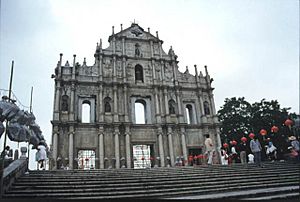
A small but growing Portuguese community lives in Japan, South Korea, China, and Taiwan. Taiwan's old name, Formosa, meaning "Beautiful (island)," came from Portuguese.
A community of 20,700 people also lives in Hong Kong, mostly of Macanese descent.
The most important Portuguese community in East Asia is in Macau. Macau was a Portuguese colony until 1999. Over 150,000 Portuguese citizens live there, making up 22.34% of the population. Portuguese influence is still very visible in Macau.
Portuguese Culture
Literature and Writers

Portuguese literature has a long and rich history. It began in the Middle Ages with troubadours, who were poets and musicians. In the 16th century, Portuguese literature had its "Golden Age." Poets like Luís de Camões became very famous. Portuguese is often called the "língua de Camões" (Camões's language), showing how important he was for the national identity.
Other famous Portuguese writers from the Age of Discoveries include Fernão Mendes Pinto. A new generation of authors appeared in the 19th century, like Almeida Garrett, who helped start modern Portuguese literature.
In the 20th century, Portuguese authors like Fernando Pessoa became famous worldwide. Pessoa is considered one of the most important Portuguese authors of the 20th century.
Today, Portuguese literature is still strong with modern authors like José Saramago and António Lobo Antunes. They write about identity, culture, and society, reflecting Portugal's rich heritage.
Law and Justice
Portugal has contributed to law and justice, especially in human rights. During the Age of Discovery, Portugal created a legal system for its overseas lands. This helped form the basis for modern international law.
Portugal also helped create the European Convention on Human Rights in 1950. This convention aims to protect human rights and freedoms.
Science and Technology
In Portugal, scientific research happens mainly at state universities and research institutes. The University of Lisbon, founded in 1290, played a big role in history. During the Age of Discovery, studying navigation was very important for Portugal's wealth.
Major Portuguese contributions to science from this time include the Caravel (a light, fast ship) and the Portolan chart (a maritime map). The Portuguese also improved navigation tools like the cross-staff.
In the 18th century, the Lisbon Academy of Sciences was founded. The Passarola, an early flying machine, was also designed then.
In 1949, the Portuguese neurologist António Egas Moniz won the Nobel Prize in Medicine. He helped develop the cerebral angiography, a way to see blood vessels in the brain.
Modern contributions from Portugal include the drug Zebinix and the All-on-4 method in dentistry. Portugal was ranked 32nd in the Global Innovation Index in 2022.
Portugal is a member of European scientific organizations like the European Space Agency (ESA) and CERN. Portuguese scientists work in these organizations.
Politics and Government
Portuguese politics works as a parliamentary democracy. The Prime Minister is the head of the government.
The president is the head of the country and has important powers. They are elected for a 5-year term and are the commander-in-chief of the armed forces. The president chooses the Prime Minister and government ministers.
The Government and the Portuguese Parliament make laws. The Parliament members are elected by public vote for a four-year term. If there are big problems or no government can be formed, the president can dissolve the Parliament and call for new elections.
Since 1976, the Socialist Party and Social Democratic Party have been the main political parties.
The courts in Portugal are independent from the government. The national Supreme Court is the highest court.
Economy and Business
Portugal's economy was ranked 34th in the world in 2019. Most of Portugal's international trade is with countries in the European Union (EU). Spain is Portugal's biggest trading partner.
The currency in Portugal is the euro (€). It replaced the Portuguese escudo in 2002. Portugal's national bank is Banco de Portugal.
Portugal has many large companies known around the world. These include The Navigator Company (paper), Sonae Indústria (wood panels), and Corticeira Amorim (cork). EDP Renováveis is one of the world's largest producers of wind energy. TAP Air Portugal is a leading airline between Europe, Africa, and South America.
Education in Portugal has improved a lot since the 1970s. In 2015, 15-year-old students in Portugal scored above average in reading, math, and science tests. Portugal has many recognized universities and business schools.
Food and Cooking
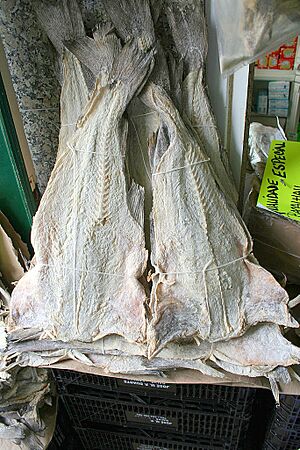
The oldest cookbook on Portuguese cooking is from the 16th century. It describes recipes for beef, fish, and other traditional foods.
Portugal is a world leader in making strong red and dry white wines. Port wine and Madeira wine come from Portugal. Farmers also grow pears, apples, plums, cherries, olives, and citrus fruits. They also grow wheat, rye, corn, and oats.

Fishing is also very important in Portugal, especially for sardines. Both men and women work as fishermen.
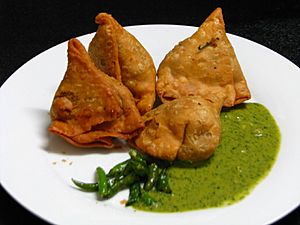
Portuguese food uses a lot of meats (pork, beef, chicken), seafood (fish, lobster, shrimp), vegetables, and sweets. Portuguese people traditionally eat a lot of carbohydrates like bread, rice, and potatoes. They eat more rice per person than any other European country.
Portuguese cuisine is influenced by Mediterranean cuisine and foods from former Portuguese colonies. Starting in the 15th century, Portugal played a big role in the spice trade. Spices like piri piri, saffron, paprika, and cinnamon are used in many Portuguese dishes. Peri piri is so popular that the restaurant chain "Nando's" uses the Rooster of Barcelos, a Portuguese symbol, as its logo.
A very popular dish is "Feijoada" (bean stew). Other famous traditional dishes are Cozido à portuguesa (Portuguese stew) and Caldo verde (green soup). The most famous pastry is the pastel de nata, also known as Portuguese custard tarts.
Portugal has 19 official wine regions. The most famous Portuguese wine is 'Port' (Vinho do Porto). Another famous wine is Vinho Verde (green wine), a slightly sparkling wine from the Minho region.
Buildings and Design

Portuguese architecture includes building styles from Portugal and its former colonies. It shows influences from many cultures throughout its history, like the Romans and Moors. The Portuguese Empire spread Portuguese colonial architecture around the world.
Important Portuguese architectural styles include Romanesque, Gothic, and especially Manueline style. The Baroque and Rococo styles were also widely used. After the 1755 Lisbon earthquake, the Pombaline style became popular. It is still very visible in Portugal, especially in Lisbon.
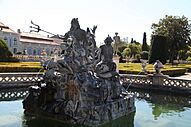
Over the centuries, many styles have shaped Portuguese architecture. Famous architects include Raul Lino and Álvaro Siza Vieira. Today, Portugal continues to have talented architects, including Pritzker Architecture Prize winners like Eduardo Souto de Moura and Siza Vieira.
Music and Sounds
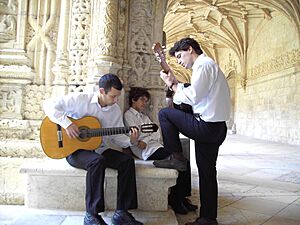
Music has always been important in Portuguese culture, from folk music to classical. Portuguese music has a rich history and many different styles.
The history of Portuguese music goes back to the Middle Ages with troubadours. In the 16th century, new musical influences came with the expansion of the Portuguese Empire. For example, the stringed instrument called the Krencong was brought from Portugal to Indonesia. The ukulele, used in Hawaiian music, also came from the Portuguese island of Madeira Island.
Fado is a very famous Portuguese music style. It started in Lisbon in the 19th century and is a symbol of Portuguese culture. Fado songs often express love, saudade (a feeling of longing), and life's difficulties. The great Fado singer Amália Rodrigues was famous worldwide. Today, artists like Mariza keep Fado alive by modernizing it.
Besides Fado, Portugal has other popular music, including Portuguese Pop Rock. This style developed in the 1980s and 1990s with bands like Xutos & Pontapés.
Other popular modern music styles in Portugal include dance, house, kizomba, and reggae.
Movies and Films
Portuguese cinema (movies) has grown a lot over the years. It started in the late 19th century with silent films shown in theaters. But it became an important part of Portuguese culture in the 1920s.
The first Portuguese film was shot in Porto in 1896. José Leitão de Barros was a pioneer in the Portuguese film industry. Director Manoel de Oliveira made many films, including "Aniki-Bóbó" (1942), which is famous for its poetic look at growing up.
In the 1950s, Hollywood films became very popular. But in the 1960s, Portuguese films gained attention again. Directors like Fernando Lopes made innovative films about politics and religion. His film "Belarmino" (1964) won an award at the Venice Film Festival.
Portuguese films have sometimes been overlooked by international festivals. However, this has changed with talented directors like Marco Martins and Pedro Costa. Pedro Costa's films have gained international recognition and competed at the Cannes Film Festival.
Portuguese directors have also become more important in the international film industry. Manoel de Oliveira was the first Portuguese director to compete for the Palme d'Or at Cannes in 1985.
Telenovelas (soap operas) are very popular in Portugal, especially due to Brazilian influence. Portugal produces many telenovelas that are famous around the world. Major TV networks like SIC and TVI produce many telenovelas each year.
Many Portuguese actors have also worked in international films.
Images for kids
See also
 In Spanish: Pueblo portugués para niños
In Spanish: Pueblo portugués para niños
- Ethnic groups in Europe
- Galicians
- Luso-Asians
- Luso-Africans
- Iberian Jews
- Portuguese American
- Portuguese Canadians
- List of Portuguese people
- Portuguese cuisine
- Portuguese culture
- Lusitanics
- Lusophone
- Portuguese language


